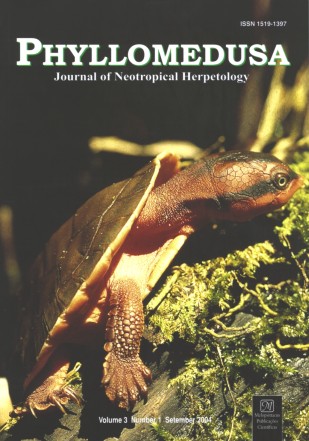Chromosomal characterization of Hyla bischoffi and Hyla guentheri (Anura, Hylidae)
DOI:
https://doi.org/10.11606/issn.2316-9079.v3i1p43-49Keywords:
Anura, Hylidae, Hyla bischoffi, Hyla guentheri, chromosomes, karyotype, cytogeneticsAbstract
Hyla bischoffi and H. guentheri share some morphological and call characters with the H. pulchella and H. polytaenia groups. The inclusion of these two species in one of these two groups is still controversial. This study showed that both species have 2n = 24 chromosomes, consisting of five metacentric, five submetacentric, and two subtelocentric chromosome pairs. The nucleolus organizer region (NOR) was located on the long arm of chromosome 10, which also presented a block of heterochromatin in both species. The pericentromeric region of all the chromosomes was positively C-banded. There were no conspicuous differences in the karyotypes of these two species, except for an additional heterochromatic C-band on the short arms of chromosome 6 in H. bischoffi. The karyotypes of these two species were very similar to those of the H. pulchella group and indicate that neither species can be excluded from that group.Downloads
Download data is not yet available.
Downloads
Published
2004-06-01
Issue
Section
Articles
License
All material originally published in Phyllomedusa belongs to Escola Superior de Agricultura Luiz de Queiroz - Universidade de São Paulo. All contents are under a license of Creative Commons BY-NC-ND.How to Cite
Raber, S. C., Carvalho, K. A., Garcia, P. C. A., Vinciprova, G., & Recco-Pimentel, S. M. (2004). Chromosomal characterization of Hyla bischoffi and Hyla guentheri (Anura, Hylidae). Phyllomedusa: Journal of Herpetology, 3(1), 43-49. https://doi.org/10.11606/issn.2316-9079.v3i1p43-49



 Impact Factor (JCR): 0.600
Impact Factor (JCR): 0.600 CiteScore: 1.0
CiteScore: 1.0